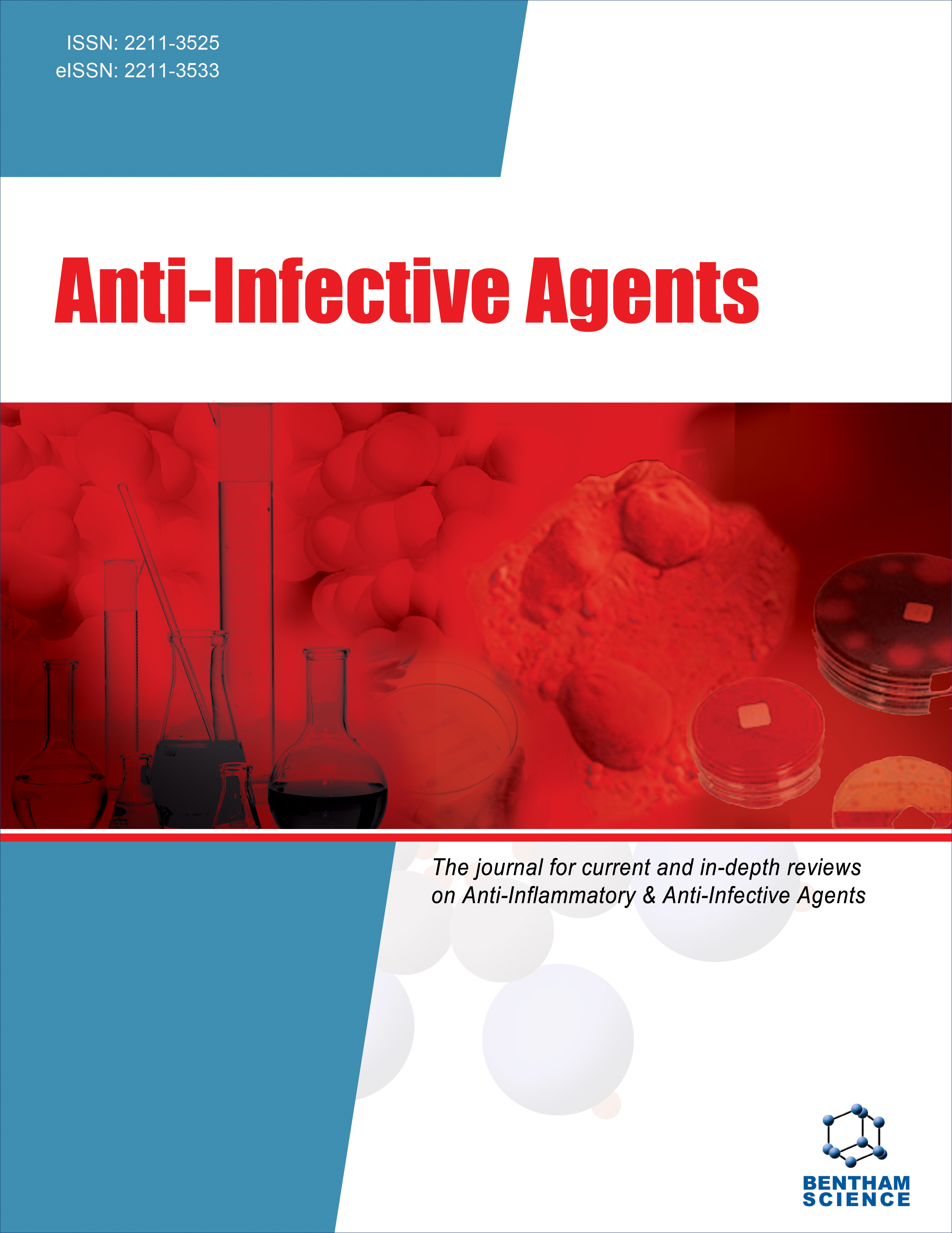- Home
- A-Z Publications
- Anti-Infective Agents
- Previous Issues
- Volume 21, Issue 2, 2023
Anti-Infective Agents - Volume 21, Issue 2, 2023
Volume 21, Issue 2, 2023
-
-
Antibiotics in Paediatrics: A Boon or a Bane?
More LessAuthors: Rupinder Kaur, Rajwinder Kaur, Ashlin Varghese, Nidhi Garg and Sandeep AroraAntibiotics play an essential role in antimicrobial therapy. Among all the medications in children, the most commonly prescribed therapy is antibiotics and is currently the indispensable means to cure transmissible diseases. Several categories of antibiotics have been introduced into clinical practice to treat microbial infections. Reducing the unnecessary use of antibiotics is a global need and priority. This article aims t Read More
-
-
-
A Review of Pyridine and Pyrimidine Derivatives as Anti-MRSA Agents
More LessAuthors: Adarsh Kumar, Ankit K. Singh, Suresh Thareja and Pradeep KumarBackground: Methicillin-resistant Staphylococcus aureus (MRSA) is a Gram-positive strain whose resistance against existing antibiotics is a significant concern for researchers across the globe. Gram-positive infections, particularly methicillin-resistant Staphylococcus aureus spreading among S. aureus isolates, increased exponentially from 29% in 2009 to 47% in 2014. Literature reviews revealed that about 13-74% of S Read More
-
-
-
Therapeutic uses of Antihistamines in the Management of COVID-19: A Narrative Review
More LessBackground: The first case of COVID-19 emerged in China in 2019 and spread rapidly worldwide. Therefore, all researchers worldwide sought ways to treat and prevent the disease. Since the production of vaccines and new drugs is time-consuming, a good way is to look at existing drugs to find new effects. Objective: Due to the pathogenic mechanism of COVID-19, most of its symptoms, including anosmia, ageusia, and cytokine Read More
-
-
-
Morelloflavone as Phytomedicine-An Ethnopharmacological Review on the Therapeutical Properties, Biological Efficacy and Pharmacological Activity
More LessBackground: Flavonoids are low molecular weight class secondary metabolites found to be present throughout the plant kingdom. Structurally, flavonoid class phytochemicals consist of C6-C3-C6 chemical structures with different substitution patterns and have drug-like nature. Morelloflavone is a biflavonoid class phytochemical found to be present abundantly in the Garcinia genus. Morelloflavone has been inves Read More
-
-
-
Calprotectin as a Serodiagnostic Marker for Bacterial Sepsis
More LessAuthors: Zahra Bakhshiani, Saloomeh Fouladi and Faranak RezaeiIntroduction: Since sepsis is a major global health problem, a rapid and correct diagnosis and the initiation of therapy are essential patient consequences. This study aimed to assess the serum levels of calprotectin and a more widely used sepsis biomarker in the patients with bacterial sepsis (BS). Methods: Subjects were classified into BS group with the patients who met the sepsis criteria at the beginning of the study a Read More
-
-
-
Hydroxychloroquine and Mortality in SARS-Cov-2 Infection; the HOPECovid- 19 Registry
More LessAuthors: Iván J. Núñez-Gil, Luis Ayerbe, Cristina Fernandez-Pérez, Vicente Estrada, Charbel M. Eid, Ramón Arroyo-Espliguero, Rodolfo Romero, Víctor Manuel Becerra-Muñoz, Aitor Uribarri, Gisela Feltes, Daniela Trabattoni, María Molina, Marcos García Aguado, Martino Pepe, Enrico Cerrato, Jia Huang, Thamar Capel Astrua, Emilio Alfonso, Alex F. Castro-Mejía, Sergio Raposeiras-Roubin, Luis Buzón, Carolina Espejo Paeres, Alba Mulet, Nisha Lal-Trehan, Elisa Garcia-Vazquez, Oscar Fabregat-Andres, Ibrahim Akin, Fabrizio Ascenzo, Paula Gomez-Rosado, Fabrizio Ugo, Antonio Fernández-Ortiz and Carlos MacayaBackground: Hydroxychloroquine (HCQ) may be an effective, safe, and affordable treatment for Covid-19 that can be used in selected patients. However, more evidence on its association when it is used in different stages of the disease with clinical outcomes is required. This observational study investigates the association between treatment with HCQ and mortality in patients with Covid-19. Methods: The data from 6217 pa Read More
-
-
-
Successful Combination of Remdesivir and Convalescent Plasma to Treat a Patient with Rituximab-Related B-Cell Deficiency and Prolonged COVID-19: A Case Report
More LessAuthors: Giorgio Raho, William Cordeddu, Davide Firinu, Stefano Del Giacco and Goffredo AngioniBackground: Treatment of severe acute respiratory syndrome coronavirus 2 (SARS-CoV-2) infection in immuno-compromised patients with complete B cell depletion can be really challenging due to the lack of seroconversion and long-lasting disease. Case Report: We describe a case of long-lasting coronavirus disease (COVID-19) in a female patient with rheumatoid arthritis who was treated with rituximab and continued Read More
-
-
-
Complete Inhibition of Human Rotavirus Infection by the Aqueous Extract of Scrophularia variegata
More LessAuthors: Pegah Khales, Fariba Shahi, Saied Ghorbani, Abdoulreza Esteghamati, Shirin Sayyahfar, Khadijeh Khanaliha, Farah Bokharaei-Salim, Seyed J. Kiani, Seyed Hamidreza Monavari, Sara Minaeian, Mohammad Farahmand, Vahdat Poortahmasebi, Fatemeh Faraji, Mehri Naghdalipoor, Zahra Habib, Mohammad Mehdi Saghafi and Ahmad tavakoliBackground: Recently, plant-based medications have been considered promising. Scrophularia has been demonstrated to have antibacterial, antifungal, antiparasitic, anticancer, and antiinflammatory effects; however, no evidence of its antiviral potency is available. Objective: This study aimed to evaluate whether the aqueous extract of Scrophularia variegata has antiviral activity against rotavirus as the leading cause of Read More
-
-
-
Seasonal Variations in the Chemical Composition of Essential Oil and Antifungal and Larvicidal Activities of Marrubium vulgare, an Aromatic Plant Growing Wild in West-Algeria
More LessBackground: Essential oil of M. vulgare is an important natural source that can be useful in controlling the infection of tomatoes and larvicides. Introduction: This work aimed to determine seasonal variations (winter, spring and summer) of the composition of M. vulgare essential oil and fungicidal and larvicidal potential of this oil. Methods: Essential oils were obtained by a Clevenger-type apparatus and analyzed by using Read More
-
Volumes & issues
Most Read This Month
Article
content/journals/aia
Journal
10
5
false
en


